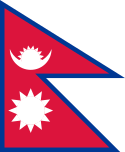Nepal: Difference between revisions
→Culture: Completed sentence (hopefully making sense) |
No edit summary |
||
| Line 117: | Line 117: | ||
The [[Nepali Congress Party]] (NCP), established in the [[1940s]], is the oldest party in Nepal. Other major parties are the [[Communist Party of Nepal (Unified Marxist-Leninist)]] (CPN-UML), the pro-royalist [[National Democratic Party (Nepal)|National Democratic Party]] (NDP) and the [[Communist Party of Nepal (Marxist-Leninist)]] (CPN-ML), a faction of the CPN-UML. Governments in Nepal have tended to be highly unstable; no government has survived for more than two years, either through internal collapse or parliamentary dissolution by the monarch. In 2005, Prime Minister [[Sher Bahadur Deuba]] and other ministers were placed under [[house arrest]], and King Gyanendra dissolved the parliament and declared a "[[state of emergency]]" which lasted till April. In [[August 2005]] Deuba was jailed after a Royal Commission found him guilty of corruption. According to a statement by Nepalese government in September 2005, parliamentary elections are to be held within the next two years. |
The [[Nepali Congress Party]] (NCP), established in the [[1940s]], is the oldest party in Nepal. Other major parties are the [[Communist Party of Nepal (Unified Marxist-Leninist)]] (CPN-UML), the pro-royalist [[National Democratic Party (Nepal)|National Democratic Party]] (NDP) and the [[Communist Party of Nepal (Marxist-Leninist)]] (CPN-ML), a faction of the CPN-UML. Governments in Nepal have tended to be highly unstable; no government has survived for more than two years, either through internal collapse or parliamentary dissolution by the monarch. In 2005, Prime Minister [[Sher Bahadur Deuba]] and other ministers were placed under [[house arrest]], and King Gyanendra dissolved the parliament and declared a "[[state of emergency]]" which lasted till April. In [[August 2005]] Deuba was jailed after a Royal Commission found him guilty of corruption. According to a statement by Nepalese government in September 2005, parliamentary elections are to be held within the next two years. |
||
At the time of writing, the people are striking against the king's policies and all the parties (all the Governmental Parties invovled) and the Maoists have joined hands to stage dharnas against the King's idea of multi-party democracy. |
At the time of writing, the people are striking against the king's policies and all the parties (all the Governmental Parties invovled) and the Maoists have joined hands to stage dharnas against the King's idea of multi-party democracy. However, as a result of civil unrest, King Gyanendra declared that the "power would be returned to the people" on April 21, 2006. |
||
==Military and foreign affairs== |
==Military and foreign affairs== |
||
Revision as of 14:07, 21 April 2006
Kingdom of Nepal नेपाल अधिराज्य Nepal Adhirajya | |
|---|---|
| Motto: जननी जन्मभूमिष्च स्वर्गादिप गरियिस (Sanskrit: Mother and Motherland are greater than the kingdom of heaven) | |
| Anthem: Rastriya Gaan | |
 | |
| Capital and largest city | Kathmandu |
| Official languages | Nepali |
| Government | Absolute Monarchy |
| Unification | |
• Water (%) | 2.8 |
| Population | |
• July 2005 estimate | 27,676,547 (40th) |
• 2001 census | 23,151,423 |
| GDP (PPP) | 2005 estimate |
• Total | $42.17 billion (81st) |
• Per capita | $1,500 (196th) |
| HDI (2003) | 0.526 low (136th) |
| Currency | Rupee (NPR) |
| Time zone | UTC+5:45 (NPT) |
• Summer (DST) | UTC+5:45 (not observed) |
| Calling code | 977 |
| ISO 3166 code | NP |
| Internet TLD | .np |
The Kingdom of Nepal (IPA: [[nəˈpɑːl]] ) is a landlocked Himalayan country in South Asia, bordering the People's Republic of China to the north and India to the south, east and west. Nepal is the world's only Hindu monarchy, and over 80% of its people follow this faith. For a relatively small country, the Nepali landscape is uncommonly diverse, ranging from the humid Terai in the south to the lofty Himalayas in the north. Nepal boasts eight of the world's ten highest mountains, including Mount Everest on the border with China. Kathmandu is the capital and largest city. The origin of the name Nepal is uncertain, but the most popular understanding is that it derived from Ne (holy) and pal (cave).
After a long and rich history, during which the region splintered and coalesced under a variety of absolute rulers, Nepal became a constitutional monarchy in 1990. This arrangement was marked by increasing instability, both in the parliament and, since 1996, in large swathes of the country that have been fought over by Maoist insurgents. The Maoists have sought to overthrow the monarchy and establish their form of republic. This has led to a civil war in which more than 12,000 people have died (see Nepalese civil war). On the pretext of quashing the insurgents, who now control about 70% of the country, the king unilaterally declared a "state of emergency" early in 2005, closing down the parliament and assuming all executive powers.
History
Neolithic tools found in the Kathmandu Valley indicate that people have been living in the Himalayan region for at least 9,000 years. It appears that people who were probably of Tibeto-Burman ethnicity lived in Nepal 2,500 years ago. Template:Inote
Indo-Iranian / Aryan tribes entered the valley around 1500 BCE. Around 1000 BCE, small kingdoms and confederations of clans arose. One of the princes of the Sakya confederation was Siddharta Gautama (563–483 BCE), who renounced his royalty to lead an ascetic life and came to be known as the Buddha ("the enlightened one").
By 250 BCE, the region came under the influence of the Mauryan empire of northern India, and later became a puppet state under the Gupta Dynasty in the 4th century CE. From the late 5th century CE, rulers called the Licchavis governed the area. The Licchavi dynasty went into decline in the late 8th century and was followed by a Newari era, from 879, although the extent of their control over the entire country is uncertain. By late 11th century, southern Nepal came under the influence of the Chalukaya Empire of southern India. Under the Chalukayas, Nepal's religious establishment changed as the kings patronised Hinduism instead of the prevailing Buddhism.

By the early 12th century, leaders were emerging whose names ended with the Sanskrit suffix malla ("wrestler"). Initially their reign was marked by upheaval, but the kings consolidated their power over the next 200 years. By late 14th century much of the country began to come under a unified rule. This unity was short-lived: in 1482 the kingdom was carved into three -- Kathmandu, Patan, and Bhadgaon -- which had petty rivalry for centuries.
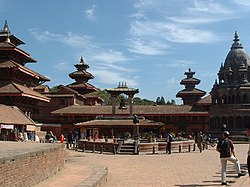
In 1765 the Gorkha ruler Prithvi Narayan Shah set out to unify the kingdoms, after first seeking arms and aid from India and buying the neutrality of bordering Indian kingdoms. After several bloody battles and sieges, he managed to unify Nepal three years later. This marked the birth of the modern nation of Nepal. A dispute and subsequent war with Tibet over control of mountain passes forced Nepal to retreat and pay heavy repatriations. Rivalry with the British East India Company over the annexation of minor states bordering Nepal eventually led to the Anglo-Nepalese War (1815–16), in which Nepal suffered a complete rout. The Treaty of Sugauli ceded parts of the Terrai and Sikkim to the Company in exchange for Nepalese autonomy.
Factionalism among the royal family led to instability after the war. In 1846, a discovered plot to overthrow Jang Bahadur, a fast-rising military leader by the reigning queen, led to the Kot Massacre. Armed clashes between military personnel and administrators loyal to the queen led to the execution of several hundred princes and chieftains around the country. Bahadur won and founded the Rana lineage. The king was made a titular figure, and the post of Prime Minister was made powerful and hereditary. The Ranas were staunchly pro-British, and assisted the British during the Sepoy Rebellion in 1857, and later in both World Wars. In 1923 the United Kingdom and Nepal formally signed an agreement of friendship, in which Nepal's independence was recognised by the UK.

In the late 1940s, emerging pro-democracy movements and political parties in Nepal were critical of the Rana autocracy. Meanwhile, China annexed Tibet in 1950, making India keen on stability in Nepal, to avoid an expansive military. Thus India sponsored Tribhuvan as Nepal's new king in 1951, and a new government, mostly comprising the Nepali Congress Party. After years of power wrangling between the king and the government, the democratic experiment was dissolved in 1959, and a "partyless" panchayat system was made to govern Nepal. In 1989, the "Jan Andolan" (People's) Movement forced the monarchy to accept constitutional reforms and establish a multiparty parliament in May 1991.
In 1996, the Communist Party of Nepal (Maoist) started a bid to replace the parliamentary system with a socialist republic. This led to the Nepal Civil War with more than 12,000 deaths. On June 1, 2001, the Heir Apparent Dipendra went on a killing spree in the royal palace, in response to his parents' rejection of his choice of wife. Following the carnage, the throne was inherited by Birendra's brother Gyanendra. In the face of unstable governments and a Maoist siege on the Kathmandu Valley in August 2004, popular support for the monarchy waned.
On 2005-02-01, Gyanendra dismissed the entire government and assumed full executive powers to quash the Maoist movement. Template:Inote In September 2005, the Maoists declared a three-month unilateral ceasefire. A few weeks later, the government stated that parliamentary elections would be held by 2007.Template:Inote
Geography

Nepal is of roughly rectangular shape, 650 km wide and 200 km broad, with an area of 147,181 km². Nepal is commonly divided into three physiographic areas: the Mountain, Hill, and Terai Regions. These ecological belts run east-west and are bisected by Nepal's major river systems.
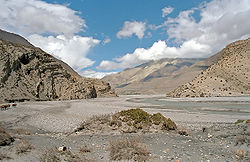
The Terai Plains bordering India are part of the northern rim of the Indo-Gangetic plains. They were formed and are fed by three major rivers: the Kosi, the Narayani (India's Gandak River), and the Karnali. This region has a hot, humid climate.
The Hill Region (Pahar in Nepali) abuts the mountains and varies from 1,000 to 4,000 m in altitude. Two low mountain ranges, the Mahabharat Lekh and Shiwalik Range (also called the Churia Range) dominate the region. The hilly belt includes the Kathmandu Valley, the country's most fertile and urbanised area. Despite its geographical isolation and limited economic potential, the region always has been the political and cultural centre of Nepal. Unlike the valleys, elevations above 2,500 m are sparsely populated.
The Mountain Region contains the highest region in the world. The world's highest mountain, Mount Everest (Sagarmatha in Nepali) at 8,850 m is located on the border with China. Eight of the world's ten highest mountains are located in Nepal. Kanchenjunga, the world's third highest peak, is also located on its eastern border with Sikkim. Deforestation is a major problem in all regions, with resulting erosion and degradation of ecosystems.
Nepal has five climatic zones, broadly corresponding to altitude. The tropical and subtropical zones lie below 1,200 m, the temperate zone 1,200 to 2,400 m, the cold zone 2,400 to 3,600 m, the subarctic zone 3,600 to 4,400 m, and the arctic zone above 4,400 m. Nepal experiences five seasons: summer, monsoon, autumn, winter and spring. The Himalaya blocks cold winds from Central Asia in winter, and forms the northern limit of the monsoon wind patterns.
Although Nepal shares no boundary with Bangladesh, the two countries are separated by a narrow strip of land about 24 km wide, called the Chicken's Neck. Efforts are underway to make this area a free-trade zone.
Economy
Nepal is one of the poorest and least developed nations in the world; up to half of its people live below the poverty line. Agriculture sustains 80% of the population and accounts for about 40% of the GDP; services comprise 40%, and industry 20%. Hilly and mountainous terrain in the northern two-thirds of the country has made the building of roads and other infrastructure difficult and expensive. There are just over 4,000 km of paved roads, and one 59 km railway line in the south. Aviation is in a better state, with 46 airports, nine of them with paved runways. There is fewer than one telephone per 46 people; landline services are poor, although mobile telephony is in a reasonable state in some parts of the country. There are around 100,000 Internet connections, but after the imposition of the "state of emergency", intermittent losses of service have been reported.Template:Inote
A lack of natural resources, its landlocked location, technological backwardness and the long-running civil war have also prevented Nepal from fully developing its economy. The country receives foreign aid from India, China, the United States, Japan and the European Union. The government's budget is about US$665 million, with expenditures of $1.1bn. The inflation rate has dropped to 2.9% after a period of higher inflation during the 1990s. The Nepalese Rupee has been tied to the Indian Rupee at an exchange rate of 1.6 for many years. Since the loosening of exchange rate controls in the early 1990s, the black market for foreign exchange has all but disappeared. A long-standing economic agreement underpins a close relationship with India.
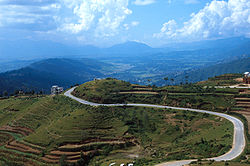
The distribution of wealth among people is consistent with that in many developed and developing countries: the highest 10% of households receive nearly 30% of the national income, and the lowest 10% a little more than 10% of that.
Nepal's workforce of about 10 million suffers from a severe shortage of skilled labour. Agriculture employs 81% of the workforce, services 16% and manufacturing/craft-based industry 3%. Agricultural produce——mostly grown in the Terrai region bordering India——includes rice, corn, wheat, sugarcane, root crops, milk, and water buffalo meat. Industry mainly involves the processing of agricultural produce, including jute, sugarcane, tobacco, and grain. The spectacular landscape and deep, exotic culture of Nepal represents considerable potential for tourism, but growth in this export industry has been stifled by recent political events. The rate of unemployment and underemployment approaches half of the working-age population. Thus many Nepalese move to India in search of work. Poverty is acute and many of Nepal's women are sold to Indian brothels, 7,000 each year.[1] Nepal receives US$50 million a year through the Gurkha soldiers who serve in the Indian and British armies and are highly esteemed for their skill and bravery.
Nepal's GDP for the year 2005 is estimated at just over US$37bn (adjusted to Purchasing Power Parity), making it the 83rd-largest economy in the world. Per-capita income is around US$1,402, ranked 163rd. Nepal's exports of mainly carpets, clothing, leather goods, jute goods and grain total $568 million. Import commodities of mainly gold, machinery and equipment, petroleum products and fertiliser total US$1.419 bn. India (48.8%), the US (22.3%), and Germany (8.5%) are its main export partners. Nepal's import partners include India (43%), the United Arab Emirates (10%), China (10%), Saudi Arabia (4.4%), and Singapore (4%).Template:Inote
Government and politics
This article documents a current event. Information may change rapidly as the event progresses, and initial news reports may be unreliable. The latest updates to this article may not reflect the most current information. |
Until 1990, Nepal was an absolute monarchy under the executive control of the king. In 1990, King Birendra agreed to large-scale political reforms by creating a parliamentary monarchy with the king as head of state and a prime minister as head of government.
Nepal's legislature is bicameral constituting of a House of Representatives and a National Council. The House of Representatives consists of 205 members directly elected by the people. The National Council has 60 members, 10 nominated by the king, 35 elected by the House of Representatives and the remaining 15 elected by an electoral college made up of chairs of villages and towns. The legislature has a five-year term, but can be dissolved by the king before its term ends. All males and females 18 years and older may vote.
The executive comprises the King and the Council of Ministers (the Cabinet). The leader of the coalition or party securing the maximum seats in an election is appointed as the Prime Minister. The Cabinet is appointed by the king on the recommendation of the Prime Minister. The judiciary is made of the Sarbochha Adalat—the Supreme Court, appellate courts and various district courts. The Chief Justice of the Supreme Court is appointed by the monarch on recommendation of the Constitutional Council; the other judges are appointed by the monarch on the recommendation of the Judicial Council.
The Nepali Congress Party (NCP), established in the 1940s, is the oldest party in Nepal. Other major parties are the Communist Party of Nepal (Unified Marxist-Leninist) (CPN-UML), the pro-royalist National Democratic Party (NDP) and the Communist Party of Nepal (Marxist-Leninist) (CPN-ML), a faction of the CPN-UML. Governments in Nepal have tended to be highly unstable; no government has survived for more than two years, either through internal collapse or parliamentary dissolution by the monarch. In 2005, Prime Minister Sher Bahadur Deuba and other ministers were placed under house arrest, and King Gyanendra dissolved the parliament and declared a "state of emergency" which lasted till April. In August 2005 Deuba was jailed after a Royal Commission found him guilty of corruption. According to a statement by Nepalese government in September 2005, parliamentary elections are to be held within the next two years.
At the time of writing, the people are striking against the king's policies and all the parties (all the Governmental Parties invovled) and the Maoists have joined hands to stage dharnas against the King's idea of multi-party democracy. However, as a result of civil unrest, King Gyanendra declared that the "power would be returned to the people" on April 21, 2006.
Military and foreign affairs
- Main articles: Military of Nepal, Foreign relations of Nepal

Nepal's military consists of the Royal Nepalese Army which includes the Royal Nepalese Army Air Service, (the air force unit under it), and the Nepalese Police Force. Service is voluntary and the minimum age for enlistment is 18 years. Nepal spends $99.2 million (2004) on its military—1.5% of its GDP. The king is the commander-in-chief of the military, which is currently engaged in the civil war against the Maoist insurgents. Most of the equipment and arms are supplied by India.[2]
Nepal has close ties with both of its neighbours, India and China. In accordance with a long standing treaty, Indian and Nepalese citizens may travel to each others' countries without a passport or visa. Nepalese citizens may work in India without legal restriction. Although Nepal and India typically have close ties, from time to time Nepal becomes caught up in the problematic Sino-Indian relationship. India considers Nepal as part of its realm of influence, and views Chinese aid with concern. Some Indians consider Nepal to be part of a greater pan-Indian state, an attitude that has caused Nepalese antagonism towards India. In 2005, after King Gyanendra took over, Nepalese relations with India, the US, and the UK have worsened. These three foreign countries have been vociferous opponents to the crackdown on civil liberties in Nepal. China mainly seeks cooperation with Nepal on the issues of Tibet. Outside of Asia, Nepal has especially friendly relations with Germany[1] and has historical military links with the United Kingdom.
Subdivisions
Nepal is divided into 14 zones and 75 districts grouped into five development zones. Each district is headed by a chief district officer responsible for maintaining law and order and coordinating the work of field agencies of the various government ministries.
| Zones: | ||
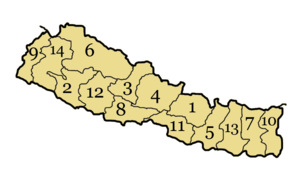 | ||
Divisions:
- Far Western: Mahakali (9), Sethi (14)
- Mid Western: Karnali (6) Bheri (2), Rapti (12)
- Western: Dhawalagiri (3), Gandaki (4), Lumbini (8)
- Central: Bagmati (1), Janakpur (5), Narayani (11)
- Eastern: Sagarmatha (13), Kosi (7), Mechi (10)
Demographics
Nepal has a total population of 27,676,547 as of July 2005, with a growth rate of 2.2%. 39% of the population is up to 14 years old, 57.3% are aged between 15 and 64, and 3.7% above 65. The median age is 20.07 (19.91 for males and 20.24 for females). There are 1,060 males for every 1,000 females. Life expectancy is 59.8 years (60.9 for males and 59.5 for females). Total literacy rate is 45.2% (62.7% for males and 27.6% for females).
The largest ethnic group is the Chhettri (15.5%). Other groups are the Brahman-Hill 12.5%, Magar 7%, Tharu 6.6%, Tamang 5.5%, Newar 5.4%, Muslim 4.2%, Kami 3.9%, Yadav 3.9%, other 32.7%, unspecified 2.8%. According to the 2001 census, Hindus constitute 80.6% of the population. Buddhists make up 10.7%, Muslims 4.2%, Kirant 3.6%, other religions 0.9%. Nepali is the national language with 47.8% of the population speaking it as their first language. Other languages include Template:Ll 12.1%, Bhojpuri 7.4%, Tharu (Dagaura/Rana) 5.8%, Tamang 5.1%, Newar 3.6%, Magar 3.3%, Awadhi 2.4%, other 10%, unspecified 2.5%. Differences between Hindus and Buddhists have been in general very subtle and academic in nature due to the intermingling of Hindu and Buddhist beliefs. Both share common temples and worship common deities and many of Nepal's Hindus could also be regarded as Buddhists. Template:InoteBuddhists are mostly concentrated in the eastern regions and the central Terrai. Buddhism was relatively more common among the Newar and Tibeto-Nepalese groups. Among the Tibeto-Nepalese, those most influenced by Hinduism were the Magar, Sunwar, and Rai peoples. Hindu influence is less prominent among the Gurung, Limbu, Bhutia, and Thakali groups, who employ Buddhist monks for their religious ceremonies.Template:Inote Template:Inote Hinduism is the official religion of the country, making it the only officially Hindu nation.
The northern mountains are sparsely populated. A majority of the population live in the central highlands despite the migration of a significant section of the population to the fertile Terrai belt in recent years. Kathmandu, with a population of 80,000, is the largest city in the country.
Culture
Nepalese culture is influence by the bordering Indian culture to the south and Tibetan culture to the north. Similarities can be observed in the clothing, way of life, language and food. A typical Nepalese meal is dal-bhat, boiled lentils served with rice and usually vegetables. This is consumed twice daily, once in the morning and again after sunset. Between these main meals, snacks such as chiura (beaten rice) and tea are consumed. Meat, eggs, and fish are also consumed, particularly in the mountainous regions, where the diet tends to be richer in protein. Millet-based alcoholic drinks are popular, including jaad and the distilled rakshi.
Folklore is an integral part of Nepalese society. Traditional stories are rooted in the reality of day-to-day life—tales of love, affection, battles, and demons and ghosts; they reflect and explain local lifestyles, cultures and belief systems. Many Nepalese folktales are enacted in dance and music. The Newar people are well-known for masked dances that tell stories of the gods and heroes. Music is percussion-based, sometimes with flutes or shawm accompanying the intense, nasal vocal lines. Musical styles are a variety of pop, religious and folk music, among other styles. Musical genres from Tibet and India have had a strong influence on traditional Nepalese music. Women, even of the musician castes, are less likely than men to play music, except in specific situations such as traditional all-female wedding parties.

The sarangi, a four-stringed, hand-carved instrument is usually played by wandering minstrels. In recent times, Nepali rock or rock music, sung to Nepali lyrics, has become popular among youth. Soccer is the most popular sport, followed by cricket and kabaddi. The Martyrs Soccer League is the national soccer championship.
There is one television service, although many networks, particularly those that originate in India, are available with the installation of increasingly popular satellite dishes. Lack of electrification makes this difficult. Radio is listened to throughout the kingdom; as of 2000, there were 12 radio stations.
The Nepali year begins in mid-April and is divided into 12 months. Saturday is the official weekly holiday. Main holidays include the National Day (birthday of the king) December 28, Prithvi Jayanti, (January 11), and Martyr's Day (February 18) and a mix of Hindu and Buddhist festivals such as Dashai in autumn, and Tihar late autumn. Most marriages are arranged, and divorce is rare. Polygamy is banned by law; relatively isolated tribes in the north, such as the Dolpo, practise polyandry. Nepal has a rich tradition of ceremonies, such as nwaran (the christening of a child), and the Pasni, the day a child is first fed rice, and bratabandha (the penance ceremony) and gupha for prepubescent boys and girls, respectively. In bel baha, preadolescent girls are "married" to the bel fruit tree, ensuring that the girl becomes and remains fertile.
Most houses in rural Nepal are made up of a tight bamboo framework with mud and cow-dung walls. These dwellings remain cool in summers and retain warmth in winters. Dwellings at higher altitudes are mostly timber based.
See also
- Communications in Nepal
- Foreign Relations of Nepal
- List of political parties in Nepal
- Military of Nepal
- Nepal Civil War
- Politics of Nepal
- Transport in Nepal
- Nepali cricket team
External links
- His Majesty's Government of Nepal
- Library of Congress – Nepal
- Template:Wikitravel
- Latest news reports, analysis and intelligence about Nepal on India Defence
- Official Site of the Royal Court of Nepal
- United States Department of State Profile of Nepal
Notes
References
- "A Country Study: Nepal". Federal Research Division, Library of Congress. Retrieved September 23.
{{cite web}}: Check date values in:|accessdate=(help); Unknown parameter|accessyear=ignored (|access-date=suggested) (help) - "Nepal". CIA World Factbook. Retrieved September 23.
{{cite web}}: Check date values in:|accessdate=(help); Unknown parameter|accessyear=ignored (|access-date=suggested) (help) - "Nepal". MSN Encarta. Retrieved September 23.
{{cite web}}: Check date values in:|accessdate=(help); Unknown parameter|accessyear=ignored (|access-date=suggested) (help) - "India Nepal Open Border". Nepal Democracy. Retrieved September 23.
{{cite web}}: Check date values in:|accessdate=(help); Unknown parameter|accessyear=ignored (|access-date=suggested) (help) - "Football at the heart of the Himalaya". FIFA. Retrieved September 23.
{{cite web}}: Check date values in:|accessdate=(help); Unknown parameter|accessyear=ignored (|access-date=suggested) (help) - "Etymology of the word "Nepal"". Infoclub.com.np. Retrieved September 23.
{{cite web}}: Check date values in:|accessdate=(help); Unknown parameter|accessyear=ignored (|access-date=suggested) (help) - Siddharth Srivastava. "India hits Nepal where it hurts". Asia Times Online. Retrieved September 23.
{{cite web}}: Check date values in:|accessdate=(help); Unknown parameter|accessyear=ignored (|access-date=suggested) (help) - "rudraksha".
- "Nepal: A state under siege". The South Asian: Featured Articles. Retrieved September 23.
{{cite web}}: Check date values in:|accessdate=(help); Unknown parameter|accessyear=ignored (|access-date=suggested) (help) - "Nepal: Basic Fact Sheet". Nepal homepage. Retrieved September 23.
{{cite web}}: Check date values in:|accessdate=(help); Unknown parameter|accessyear=ignored (|access-date=suggested) (help) - "Jailed ex-PM in Nepal court plea". BBC News. Retrieved September 29.
{{cite web}}: Check date values in:|accessdate=(help); Unknown parameter|accessyear=ignored (|access-date=suggested) (help) - "Timeline: Nepal". BBC News. Retrieved September 29.
{{cite web}}: Check date values in:|accessdate=(help); Unknown parameter|accessyear=ignored (|access-date=suggested) (help) - "Nepal to hold polls in two years". Times of India. Retrieved September 29.
{{cite web}}: Check date values in:|accessdate=(help); Unknown parameter|accessyear=ignored (|access-date=suggested) (help) - "Nepal". Factbook on Global Sexual Exploitation. Retrieved September 23.
{{cite web}}: Check date values in:|accessdate=(help); Unknown parameter|accessyear=ignored (|access-date=suggested) (help) - Barbara Crossette (1995). So Close to Heaven: The Vanishing Buddhist Kingdoms of the Himalayas. New York: Vintage. ISBN 0679743634.
- Bista, Dor Bahadur (1967). People of Nepal. Dept. of Publicity, Ministry of Information and Broadcasting, Govt. of Nepal. ISBN 9993304182.
- Michael Hutt, ed., Himalayan 'people's war' : Nepal's Maoist rebellion, London : C. Hurst, 2004
- Peter Matthiessen (1993). The Snow Leopard. Penguin. ISBN 0-00-272025-6.
- Joe Simpson (1997). Storms of Silence. Mountaineers Books. ISBN 0898865123.
- Samrat Upadhyay (2001). Arresting God in Kathmandu. Mariner Books. ISBN 0618043713.
- Joseph R. Pietri (2001). The King of Nepal. Joseph R. Pietri. ISBN 061511928X.
- Maurice Herzog (1951). Annapurna. The Lyons Press. ISBN 1558215492.
- Dervla Murphy (1968). The Waiting Land: A Spell in Nepal. Transatlantic Arts. ISBN 0719517451.
- Rishikesh Shaha (2001). Modern Nepal: A Political History. Manohar Publishers and Distributors. ISBN 8173044031.

